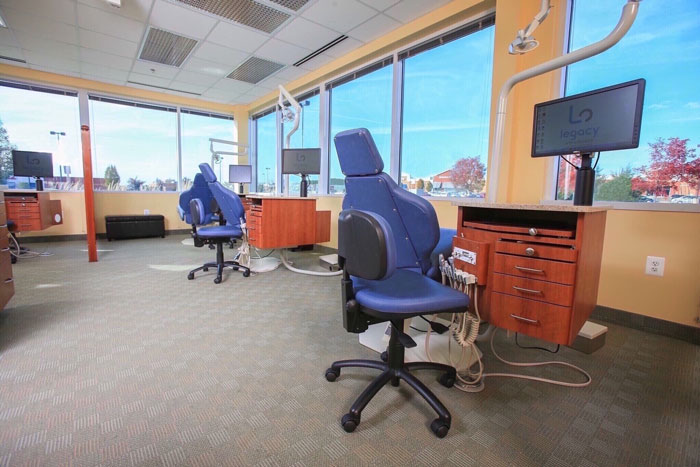Things about Legacy Orthodontics
Things about Legacy Orthodontics
Blog Article
Facts About Legacy Orthodontics Uncovered
Table of ContentsNot known Details About Legacy Orthodontics Top Guidelines Of Legacy OrthodonticsFacts About Legacy Orthodontics RevealedAn Unbiased View of Legacy OrthodonticsRumored Buzz on Legacy Orthodontics
In addition, we provide adjustable treatment schedules, versatile settlement options and an enjoyable, delightful experience.An orthodontist is a dental expert trained to identify, avoid, and treat teeth and jaw irregularities. They deal with existing problems and are trained to determine problems that may establish in the future. Orthodontists work with individuals of every ages, from kids to adults. People often associate a perfect smile with healthiness.
Malocclusion, or misaligned teeth, can lead to oral problems, including dental caries, periodontal disease, and difficult or uncomfortable chewing. But not everybody is birthed with straight teeth. If you have a negative bite or big rooms between your teeth, you may intend to speak with a dentist concentrating on orthodontic care.
Things about Legacy Orthodontics
( Picture Credit Rating: DigitalVision/Getty Images) Orthodontists utilize fixed and removable oral tools, like braces, retainers, and bands, to alter the placement of teeth in your mouth. Orthodontic therapy is for dental irregularities, consisting of: Jagged teethBite troubles, like an overbite or an underbiteCrowded teeth or teeth that are also much apartJaw misalignmentThe goal of orthodontic treatment is to enhance your bite.
A healthy and balanced bite ensures you can eat, eat, and talk properly. While you may assume of orthodontists as primarily for kids or teenagers who require dental braces, they can correct dental troubles at any age. Orthodontists attend college, dental school, and orthodontic institution. After college graduation, they invest 2 or 3 years in an orthodontic residency program.
, but not all dental professionals are orthodontists. They focus on two areas: Exactly how to properly and safely move teeth Exactly how to appropriately assist advancement in the teeth, jaw, and faceOnce an orthodontist has completed training, they have the option to come to be board licensed.
Legacy Orthodontics Things To Know Before You Get This
Malocclusion leads to tooth overcrowding, an irregular jaw, or uneven bite patterns. Malocclusion is typically treated with: Your orthodontist affixes metal, ceramic, or plastic square bonds to your teeth.
If you have only small malocclusion, you may have the ability to make use of clear braces, called aligners, as opposed to conventional dental braces (https://calendly.com/brianmccune20176-proton/30min). Some individuals need a headgear to assist move teeth right into line with stress from outside the mouth. After dental braces or aligners, you'll require to put on a retainer. A retainer is a personalized device that keeps your teeth in location.
They're most commonly utilized see it here on kids. They can produce additional space in the mouth without having to pull teeth. If you have a major underbite or overbite, you may require orthognathic surgical treatment (additionally called orthodontic surgery) to extend or reduce your jaw. Orthodontists make use of cables, surgical screws, or plates to support your jaw bone.
You might need to see an orthodontist if you have: Crowding or otherwise sufficient space for all of your teethOverbite, when your top teeth come your bottom teethUnderbite, when your bottom teeth are also much forwardSpacing or problems with gapsCrossbite, which is when your upper teeth fit behind your base teeth when your mouth is closedOpen bite or a vertical gap in between your front base and upper teethMisplaced midline, when the facility of your base and upper teeth do not line up Fixing a dental malocclusion can: Make attacking, eating, and speaking easierImprove the balance of our face and your overall appearanceEase discomfort from temporomandibular joint conditionsSeparate your teeth and make them simpler to clean, aiding stop dental cavity or cavities It's often a dental expert who initially notices misaligned teeth during a regular exam.
Getting My Legacy Orthodontics To Work

During your initial orthodontic examination, you'll likely have: An oral examPhotos taken of your face and smileDental X-raysPanoramic (360 level) X-rays of your face and headImpressions to produce mold and mildews of your teethThese tests will certainly help your orthodontist know just how to proceed with your therapy. leesburg clear braces. An orthodontist is a dental expert who's had training to treat your teeth and jaw
An orthodontist is concentrated on your bite, so something like a chipped tooth would be managed by a dentist. Orthodontists are focused on your bite, or the method your teeth fit with each other, and the straightness of your teeth.
Ever before questioned exactly how celebs constantly seem to have completely straightened teeth? The solution typically exists in the skilled hands of an orthodontist. What specifically does an orthodontist do? Orthodontists are oral professionals that concentrate on correcting irregularities in the teeth and jaws. Their experience surpasses simply creating a gorgeous smile; it includes enhancing your general oral health and wellness and feature.
The Ultimate Guide To Legacy Orthodontics

While braces are one of the most commonly acknowledged orthodontic therapy, orthodontists have a diverse toolkit at their disposal. The certain approach selected depends upon the extent of the case, the individual's age, and specific preferences. These tried-and-true braces make use of a system of brackets bonded to the teeth and connected by wires.
Clear aligners, like Invisalign, are a prominent choice for patients seeking a much more very discreet therapy alternative. These detachable trays are custom-made to gradually move the teeth's setting. Headwear might be made use of in combination with dental braces or aligners to use added targeted pressures, specifically for correcting jaw discrepancies. In situations of narrow jaws, palatal expanders can be made use of to develop room for correct tooth placement.
Report this page